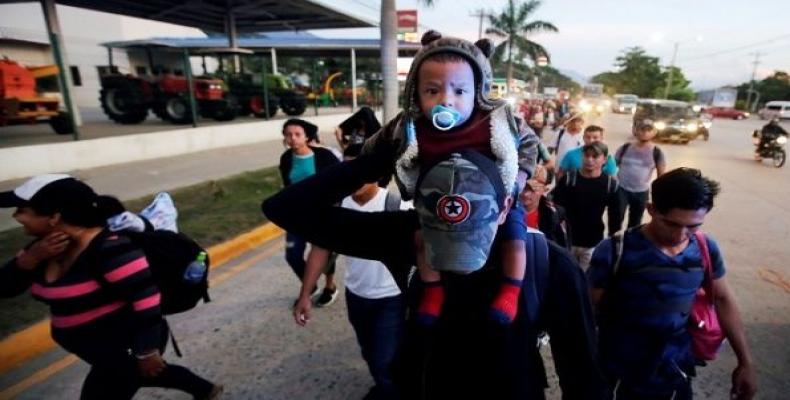San Pedro Sula, October 16 (RHC)-- Another migrant caravan has left from Honduras to the United States in order to escape poverty, violence and now major rains that have left at least six people killed since last week.
More than 1,300 people, many of whom were families with young children, set off from San Pedro Sula, Honduras toward the United States this past weekend. They left despite knowing the risks of the journey and the potential of being deported or separated from their kids by U.S. authorities at the country’s southern border as happened last March and April in accordance with the U.S. President Donald Trump’s “zero tolerance” policy implemented to deter migration in general.
“I believe we’ll get to the United States. There’s no work in Honduras, and you live in fear that they’re going to kill you or your children,” said Fanny Barahona, 35 years-old, an unemployed teacher who walked with her nine-year-old son told Reuters. She carried her two-year-old daughter.
The Hondurans joined the so-called “March of the Migrant,” and will walk through northern Honduras, into Guatemala and Mexico. Many, says organizer and leftist politician Bartolo Fuentes, will seek asylum in Mexico or request visas to pass through to the U.S. border.
The caravaners leave for a myriad of reasons, primarily because they’re trying to escape the country’s 66 percent poverty rate, 7 percent unemployment, and to avoid the constant threat of violence in Honduras that registered 48 homicides per 1,000 people in 2017.
“There is no work and so much violence that you can get killed walking down the street,” said Javier Solis, 25, who said he has not found work in a year and wants to enter the United States. On a previous attempt, he was deported back to his home country by Mexico.
Factored into these statistics is that over nine percent of the Honduran population lives in the United States and many want to be with family in the north.
San Pedro Sula has one of the country’s highest murder rates, and for the past several weeks, businesses there have had to shut down due to continual electrical blackouts by the state-owned National Electric Energy.
Simultaneously, the departments around the city of over 1.5 million have suffered the most from the tropical storm effects of Hurricane Michael that went over Central America and the Caribbean last week. The rains have left at least 11 dead and over 3,500 homeless.
This second organized wave of migration this year comes as U.S. Vice President Mike Pence met with the presidents of Honduras, Guatemala and El Salvador in Washington last week to discuss their Alliance For Prosperity, the multilateral plan meant to bring economic development to the three Central American countries known as the Northern Triangle in order to curb migration to the United States.
The program, initiated in 2014 after a major wave of Central Americans went to the United States, is also supposed to help tackle corruption, impunity and gang violence in the Northern Triangle. Guatemalan President Jimmy Morales, who himself is violating his country’s rule of law to fight corruption allegations against him and his family, asked the U.S. for $15 billion in aid at the meeting.
Honduran President Juan Orlando Hernandez said his U.S. funding was declining and called on the U.S. government to reunite migrant children with their parents after news that the minors who were separated by U.S. officials months ago at the border are now being adopted by force after their parents were deported.
Second-wave migrant caravan leaves Honduras for U.S.

Rilataj Artikoloj
Komentarioj
Lasu komentarion
Ĉiuj kampoj bezonatasPliaj Vidaĵoj
- Kreskas rekono al laboristoj de la elektra sektoro
- Usono adoptas decidojn en la ĝusta direkto, sed la blokado restas
- La BRICS-emblemo en Brazilo en 2025 estos la sumauma-kotonarbo
- Kubo kaj Ĉinio fortigas ligojn kaj proksimecon
- La mondo celebras la decidon de Usono pri Kubo kaj postulas ĉesigon de la ekonomia sieĝo

